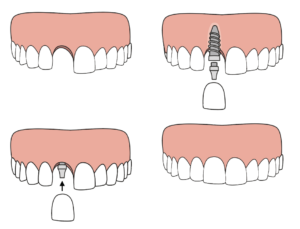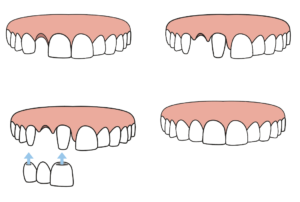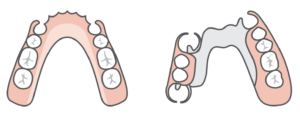You Deserve to Smile with Comfort
Dental options to replace your missing teeth
Having a missing tooth is uncomfortable. People with missing teeth often have discomfort when smiling, chewing, and even speaking. Missing a tooth can even cause the slow shifting of your teeth into some of the empty spaces. Fortunately, there are several excellent options available to replace your missing tooth to help restore your beautiful smile.
Dental Implant
Dental implants are a popular choice for people with missing teeth because they are the closest thing to a natural tooth. The implant crowns are made to resemble the shape, color, and size of your natural teeth.

The Process
It begins with the replacement of your tooth’s root with metal screws, which will be used as an anchor for the dental crown. Once the screws have been put into place, you will need to allow the implant to heal for a few months. During this time the implant becomes securely fused to your jawbone. Once the implant has healed completely, a dental crown will be placed on top and secured.
The Advantages
• One of the most effective options to replace missing teeth
• Provide a very natural look and feel
• No involvement of your adjacent teeth, so nearby teeth remain intact
• Considered a permanent, long-term tooth replacement
The Disadvantages
• Requires a more invasive surgical procedure, a significant healing time, and the possibility for infection
Dental Bridge
Dental bridges consist of one or more crowns which bridge the gap of missing teeth by being attached to the adjacent natural teeth on the other side.

The Process
The dentist will remove enamel from your adjacent natural teeth to prepare your natural teeth for the crowns. When the natural teeth have been prepared, the crowns of the bridge will be cemented onto them. The procedure is completed over a few visits.
The Advantages
• Provides the same realistic look and feel of a natural tooth
• They don’t need to be removed at night
• There is no surgery required, so the process is less invasive
The Disadvantages
• The adjacent teeth receiving the crowns will need to be filed to the appropriate size for the crown to fit, which requires removal of healthy tooth structure.
• If not properly cared for, the nearby teeth can be damaged over time
• Food particles can slip underneath the bridge and become harder to clean, which causes a greater risk of decay and bone loss
Removable Partial Denture
Removable partial dentures are specially molded and fitted to your mouth and can be removed to be cleaned. They can be used as both a short-term and long-term solution.

The Process
Before partial dentures are made, an X-ray and mold of your mouth will need to be completed, so an accurate denture can be made. The dentist will then insert a metal framework if needed, which allows for a trial fitting to take place. A removable partial denture is clasped into its correct place, which ensures that the false teeth are held in the appropriate spots..
The Advantages
• Additional teeth may be added directly to the partial denture if any teeth are lost in the future
• One of the most affordable options for tooth replacement
• Easy to repair and replace if needed
The Disadvantages
• Can be uncomfortable
• Can move around while talking or eating
• Must be removed and cleaned daily, and removed before sleeping
• Do not blend in or appear as natural as dental implants or dental bridges.
Not Replace Missing Tooth
Losing your teeth can have negative effects for both your oral health and your appearance. The longer you wait to replace it, you are at greater risk for losing more teeth, as well as other issues.

The Advantages
• More affordable than replacing your tooth
The Disadvantages
• The gap formed by a missing tooth can cause other teeth to become crooked and move out of position
• Can cause changes to your bite, making it difficult to speak and eat
• Can cause self-esteem issues, as people will feel self-conscious about smiling, eating and talking in case people see their missing tooth/teeth.
• Can cause pain and discomfort in your jaw joint



